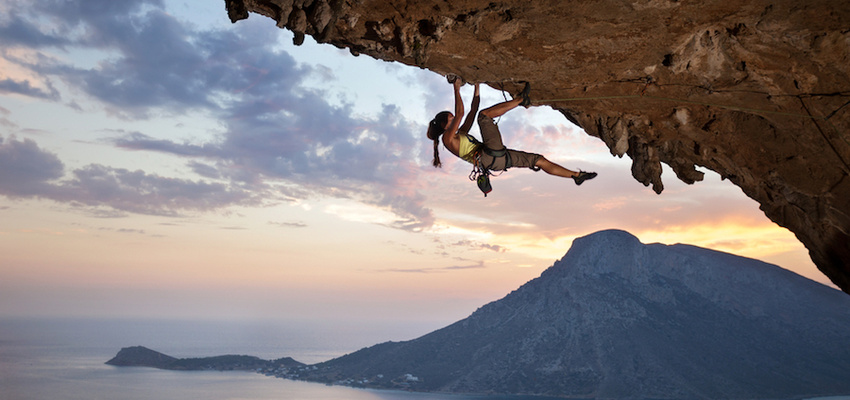Tuesday, 30 September 2014
7 Things Passionate People Do Differently
1. Their natural sexiness
Add some sparkle to your outfit or flash to your suit and move through the world knowing how sexy you really are. Take the Brazilians and the Spanish as examples: adding some extra romance to your day and dancing in the street keeps passionate people alive.
2. The beauty of other people
It’s way easier to stay passionate when you know you're surrounded by amazing people. What’s special about the guitarist playing in the subway? What makes your boss tick? Why is your significant other a magnificent human? Dwelling on the awesomeness of those around us is the key to staying passionate.
3. Their soul’s mission
It might not be how you make money, it might not even be something massive, but passionate people know what they came here to do, and they do it every day. It might be to spread love, it might be to change politics, but staying in the flow of their deepest calling keeps them on fire.
4. Food!
We eat a lot every day. Turning eating into a celebratory feast of the senses and getting excited about the taste and look of the food gives you a good excuse to be passionate three times a day.
5. Their relationships
Giving genuine compliments, taking care of the people dearest in your life makes them feel adored. The strength of those relationships, and knowing that you’ll never be lonely because you’re deeply loved keeps passion alive.
6. Dancing and physical activity
Going crazy on a dance floor or biking through the desert keeps that sparkle in the eyes of passionate people. Doing adventurous and moving things keeps energy from getting stagnant in your life — the enemy of passion!
7. Nature
Falling in love with the sunsets, the beauty of trees means there's a constant reason to be excited about the world. Passionate people don’t just walk under the stars, they rave at them and blow kisses to the universe. Get over your inner cool kid and be as hyped up about nature as you naturally feel — we are on a glorious planet, after all!
10 Reasons Everyone Should Try Rock Climbing
Are you tired of your same old workout routine? Are you looking for a great way to get fit without all the suffering and maybe even a little bit of excitement? If so, then you should try rock climbing. Here are 10 great reasons to motivate you:
1. It’s affordable to get started.
You can find some used climbing shoes to get you started for anywhere from $20 at a used-gear REI garage sale to around $80 online. Memberships to climbing gyms tend to cost around $60 per month, depending on where you live.
2. It doesn’t feel like a punishment.
Rock climbing quickly became my favorite way to work out because it’s not miserable. You can get a great full-body workout without gasping for air, drowning in sweat, or fighting the dreaded muscle burn. The next day you’ll feel sore in areas you didn’t know existed, just without all the suffering of aerobic exercise.
3. It’s different from your typical routine.
If you’re trying to lose weight or just get more toned, switching up your usual routine is often beneficial. A study in 2011 from Brown University found that people were more likely to stick to their workout regimen if they participated in a variety of exercises. So, if you’re getting bored with your typical routine, try rock climbing once a week.
4. You can improve quickly.
Rock climbing is a sport that allows you to easily track your improvements. There are so many skills to acquire and muscle groups to strengthen that you can always be improving something. This sport is very rewarding for beginners all the way to the elite, professional climbers.
5. It will feed your craving for adventure.
If you’re craving adventure or excitement, then rock climbing is definitely the activity for you. Whether you’re bouldering in the gym just 5 feet off the ground, sport climbing 60 feet off the ground, or up in the mountains climbing at 13,000 feet, this sport will definitely give you a rush of adrenaline.
According to Emory University neuroscientist Dr. Michael Davis, sports that involve more fear or excitement cause your body to release more endorphins, dopamine, and norepinephrine — neurotransmitters that are more powerful than cocaine, speed, and morphine. Once you get a taste of the excitement, you might be hooked on climbing for life!
6. It’s a full-body workout.
Climbing is definitely my favorite form of exercise because it’s enjoyable and is a great workout. You get the added benefit of strength, endurance, and flexibility training all in one activity. Rock climbing just twice a week can help you meet the American College of Sports Medicine (ACSM) recommendation of flexibility exercises twice a week, as well as the recommendation from U.S. Department of Health & Human Services to engage in full-body muscle-strengthening activities at least twice a week.
7. It’s a great way to meet people.
Rock climbing, especially in a gym, is a very social sport. There’s plenty of down time while you’re resting between climbs, so it’s very easy to meet other people if you hang out at climbing gyms. I’ve met realtors, graphic designers, web designers, architects, land surveyors, medical students, engineers, massage therapists, nurses, photographers, and firefighters all in the same climbing gym. So, if you’re looking for a workout partner or maybe just a diverse group of friends, go hang out at your local climbing gym. You’re bound to meet some amazing people.
8. It gives you something to work toward.
For me, climbing is enjoyable because it resembles a fun video game with many different levels. If you’ve ever played a game with levels, then you know how exciting it can be when you work really hard to accomplish a goal and finally succeed.
All your life you’re given goals to work toward. They may be related to education, relationships, status, career, or possessions, but at some point in life, it’s easy to feel like you’ve run out of goals. Rock climbing is a sport that can be easily measured and constantly pursued. So, if you find yourself motivated by challenges, you'll probably enjoy climbing.
9. Anyone can excel at it with time and practice.
Rock climbing is very different from other popular sports. You don’t necessarily need to be young, old, tall or short to be a great rock climber. Sure, there may be factors that predispose you to the sport, like a background in gymnastics or dance, or a wingspan 6 inches longer than your height, but generally speaking, anyone can excel at rock climbing. Some of the strongest climbers in the world range from about 13 to 35 years old. Climbing is truly a very inclusive and enjoyable sport.
10. It teaches your mind and body to work together.
Climbing is very much a physical and mental challenge. The rock presents you with a puzzle that you solve through body movements and different techniques in order to reach the top. The route may require fancy footwork, a strong core, contact strength, or just the ability to go for a hold that seems well out of your reach. No matter how much experience you have, climbing is great training for your brain. It can even help you meet the ACSM recommendations to engage in a neuromuscular activity two to three times per week to help with balance, agility and coordination.
So if you’re looking for an exciting past time, a fun group of friends, or just something different, rock climbing is an activity that you should definitely try!
5 Ways To Reconnect With Nature
If you often find yourself busy, perhaps you can relate — rushing around from one thing to the next and spending what little spare moments you have with your smartphone in hand. If the extent of your outside time is taking out the trash and walking to the mailbox, then you too have definitely gotten far away from the rhythms of nature.
But you are not alone. This is the norm in today’s modern world and if you ask me, it’s a serious problem. I believe that re-establishing a connection with Mother Earth is so crucial.
Nature will quiet your mind, open your heart and invite ease into your body. You’ll feel the living connection with life all around you, giving you the capacity to open up to something that's much bigger than yourself. Through nature you’ll transform, awaken and heal, and even get a boost in creativity, health and quality of life.
I invite you to start reconnecting with nature today. It’s not always an easy thing to do, but that doesn’t mean you aren't capable of trying.
Below are a few simple ideas to help get you reacquainted with Mother Nature. It’s best to leave the comfort of your own home and explore the wild, natural world, but if you don’t have the time or the access, I’ve included a few suggestions for indoor activities as well.
1. Make contact with the earth.
Go outside, take off your shoes and socks and sink your bare feet into the grass. If there's snow or ice on the ground, then find a tree and place your palm on the trunk. You can even give it a big tree-hug if you’re feeling the love; just lean in and wrap your arms around it.
2. Play in the dirt.
Tend to a veggie patch or an herb garden, play in the sand or make mud pies with little ones. Just as sinking your bare feet into the earth will ground you, so will digging into it with your hands.
3. Bring nature indoors.
Buy some houseplants, keep a jar of fresh flowers, put a crystal on your desk, place a jar full of seashells and sand in your living room, or start a pinecone collection.
4. Wake up with nature.
Upon waking, open your window and stand in front of it. Look outside and take in all the beauty of nature. Breathe in the colors, shapes, textures and sounds. Notice the color of the sky, the shapes of the clouds and the sounds of the birds. Allow the natural world to ground you into the here and now.
5. Kiss the earth with your feet.
One of my favorite quotes from Thich Nhat Hanh reminds us to slow down and notice nature, “Walk as if you are kissing the Earth with your feet.” The next time you walk out your front door, feel your feet connecting with the earth, step by step.
As you can see, connecting to nature doesn’t mean you have to climb Mount McKinley in Alaska, although I do recommend peaceful outdoor walks and hikes as often as possible. Let nature be where you find it and where it’s the easiest for you to access. Get outside, channel your inner child and start your reconnection with nature now!
6 Great Reasons To Go Camping!
New research is showing exactly why camping might actually be one of the most healthy activities out there.
1. You reconnect your sleep cycle to nature.
Sleep issues are huge all over the Westernized world. For millions of years we have evolved to sleep shortly after dark and rise with the sun, and recent evidence has pointed to people sleeping better (if not necessarily longer) when their sleep cycle is consistent with the sun. The mechanism has to do with the timing and production of melatonin, and our internal circadian rhythm.
2. You build your microbiome.
Another extremely exciting area of new science is the germs that live on, in and around us al the time. Getting into nature is a really effective way to improve the depth and resilience of your microbiome; the impact of that improvement on your overall health is just starting to be understood, but it's wide ranging, from decreasing inflammation to improving immunity, metabolism and digestion.
3. You get a great workout.
Not all camping involves a lot of exercise, but it certainly is conducive to it, even if it's only chopping the firewood. For most campers, daily activities can include hiking, biking, swimming and sports, all of which provide the great health benefits of exercise.
4. You reduce stress.
Stress is a huge driver of chronic health issues; stress reduction, therefore, is of upmost importance. Stillness in our surroundings can certainly make it easier to find inner stillness, especially if you add a digital detox to your camping experience. Pro tip: Camp out of cellphone range
5. You're away from artificial light.
Research has suggested that being exposed to artificial light after dark might have a role to play in the development of breast cancer, as well as other chronic diseases. The mechanism for this is likely melatonin production.
6. You build community.
One of the biggest factors in the Blue Zones research, which looked at people groups who consistently lived to 100, consistently found that community was a big component. Camping is typically done in family or friendship groups and time away in community, as well as those you meet while camping, are likely healthy on many levels.
If you are ready to experience the benefits of camping, there isn't much left of summer, so make sure you enjoy it!
10 Jaw-Dropping Places To Visit This Fall
We often think of summertime as the season of the outdoors, but in truth the fall—with its moderate temperatures, gorgeous foliage and thinned-out crowds—offers a much better opportunity to reconnect with nature. Interacting with the natural environment is essential. The simple act of setting your sights on a beautiful vista is proven to sharpen your creativity and cognitive edge, and the frolicking also helps tame stress, anxiety and other health problems.
So what are the best places to check out this Fall? We teamed up with LÄRABAR to bring you the answer to that exact question. And we couldn't have asked for a better partner to help us in that quest: after all, the LÄRABAR fruit & nut bar concept was born during a hike through the beautiful Rocky Mountains of Colorado. So grab your backpack and set off for these 10 amazing spots this Fall. You will never feel more vibrant, more inspired, and more alive.
The Wave, Utah
Talk about a perspective change: You’ve never seen anything like the undulating ripples of multicolored rock you’ll be hiking through in what’s come to be known as “The Wave.” A chute cut into the side of a sandstone mountain, the rock has eroded to reveal pink, red, green and yellow hues, along with large natural structures resembling castles, beehives and more. The thermometer easily breaks 100 degrees in summer months, so go in the fall to get the most out of your trip.
The Lost Coast, California
This 26-mile stretch of the Northern California coast was slated to become part of the Pacific Coast Highway, but plans were quickly dropped when crews caught a glimpse of extreme shoreline cliffs and generally rugged terrain. Translation: The Lost Coast offers quiet, untouched, visually spectacular hikes that will lead your boots across high mountain peaks that hover more than a mile above the surf, and deserted beaches featuring turquoise water and awe-inspiring sunsets.
Block Island, Rhode Island
This tiny Atlantic island about 10 miles off shore has just 1,000 year-round residents, giving it that “untouched” feeling that so many tourists spots lack. Boasting 25 miles of walking trails, the island offers two lighthouses, terrific views of the sea and one of the most important migratory songbird habitats in the world (70 species stop over on the island each fall!). Love the beach? Hike the entire coast of Block Island in eight hours.
Hot Springs, North Carolina
Begin or end your visit to Hot Springs on the Appalachian Trail, which runs right along Main Street of this cute mountain town. There’s an eclectic offering of shops and restaurants, outdoor activities like river kayaking and hiking, and—yes—rejuvenating mineral hot springs to sink into on a chilly autumn night. Winter can go ahead and bring it on.
Wind River Range, Wyoming
Part of the Central Rockies, this chain is universally lauded by hikers and climbers around the world. The highest range in the region, and the one with the biggest glacier system in the U.S portion of the chain, your trip will provide all the impressive vistas these mountains are known for without the big crowds. Fall offers ideal daytime temperatures for hiking—plus chilly nights that are perfect for cuddling next to the campfire.
High Falls, Minnesota
Close to the Canadian border, Minnesota’s Grand Portage State Park offers an abundance of nature. The park’s claim to fame: High Falls, a 120-foot waterfall that plunges dramatically into the Pigeon River. With the relative ease of the area’s hiking trails, feel free to lug as much photography equipment as you want. Need to blow off some steam? Take the tougher 3-mile trail through dense, secluded forest from High Falls to Middle Falls.
Little River Canyon, Alabama
Flowing atop Lookout Mountain in northeast Alabama, Little River and its accompanying hiking trail provide one of the most unforgettable hikes in the Southern Appalachians. Take in lush forest sights and sounds, beautiful waterfalls and dipping pools, canyon rims, cliffs and sandstone formations of all shapes and sizes. The vibe in this wildlife preserve is sure to inspire.
Indian Head Mountain Loop, New York
Looking to free your mind? Take on this challenging hike, in which your brain will have no choice but to limit focus on every step you take. Pack plenty of calorie-dense snacks for this strenuous 7-mile loop, which takes you through some of the most impressive overlooks in the Catskill region. After climbing more than 2,500 feet to the summit you’ll be rewarded with an absolutely breathtaking view of a fall foliage-blanketed range.
Alum Cave Trail, Tennessee
Ascend 2,700 feet over five and a half miles to reach the summit of Mount LeConte. This trail’s secret: The views from the trail are as impressive as the gorgeous vista at the top. The hike takes you through a variety of mind-blowing formations including arches, stairways and cave-like bluffs. Many consider this a must-walk of the Smoky Mountains.
Enchantment Lakes Basin, Washington
Nestled atop the Alpine Lakes Wilderness of Washington State, this area’s glittering lakes have been described as “jaw-dropping” and “magical.” About 100 miles east of Seattle, the hike will take you through 10 miles of gorgeous terrain featuring juts of granite and dazzling deep-blue lakes and tarns. In the fall, the area’s iconic larch trees turn sunburst-yellow—a stunning contrast to the environment’s dominant deeper hues. Mind. Blown.
10 Animals Threatened By Climate Change
One of the best ways to put a face on the tangible effects of climate change is to draw attention to the animals whose very existences are threatened by it. These animals play vital roles in the ecosystem, and changes in their behavior can create a domino effect on the world we share with them.
So, with that in mind, here are 10 animals under threat by global climate change:
Pika

The pika is a cute little mountain creature who requires a cool climate to thrive. With rising temperatures warming their homes, pikas are being forced to move to higher altitudes, but there's only so far they can go before they run out of room completely.
Adélie Penguins

This pole dweller is another animal that must cope with receding ice shelves in the Antarctic. Recent research has actually shown that Adélie penguin populations are increasing, a reminder that climate change is just that: change.
Population increases in themselves aren't necessarily positive signs; they're a reminder that we're still struggling to understand the far-reaching consequences of climate change.
Population increases in themselves aren't necessarily positive signs; they're a reminder that we're still struggling to understand the far-reaching consequences of climate change.
Corals
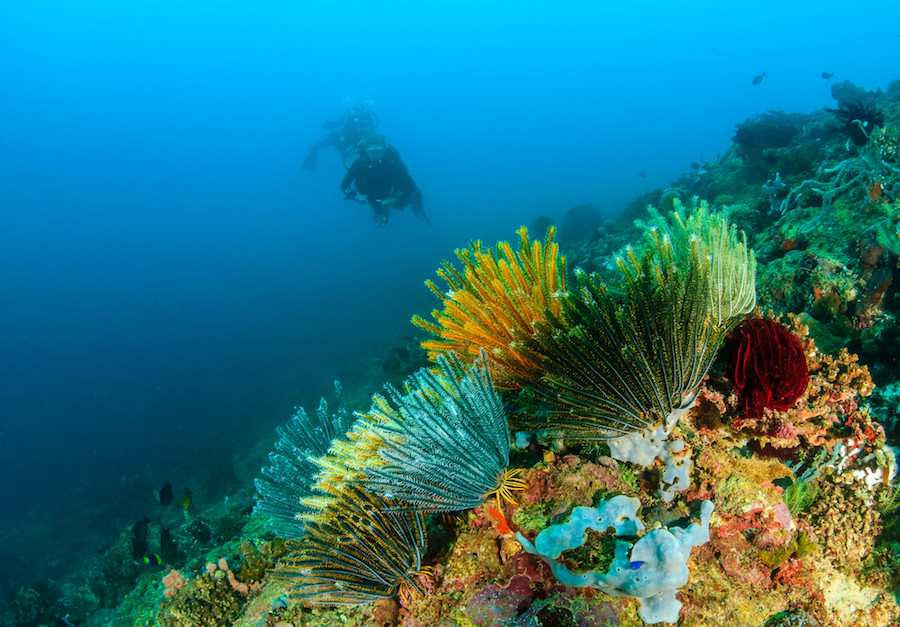
Coral reefs are the backbone of many ocean ecosystems, serving as filters, food sources, living quarters, and hiding spots for a host of underwater critters. Corals are so important that more than 25% of the ocean's animals make their homes in coral reefs.
Corals have a symbiotic relationship with algae called zooxanthellae, which give reefs their rich color palate. Rising temperatures force corals to expel the algae, leading to a phenomenon known as coral bleaching, which is corals' way of surviving stress ... as long as the stress is temporary. With climate change warming the ocean (combined with myriad other menaces), 75% of coral reefs are currently under threat.
Corals have a symbiotic relationship with algae called zooxanthellae, which give reefs their rich color palate. Rising temperatures force corals to expel the algae, leading to a phenomenon known as coral bleaching, which is corals' way of surviving stress ... as long as the stress is temporary. With climate change warming the ocean (combined with myriad other menaces), 75% of coral reefs are currently under threat.
Seals
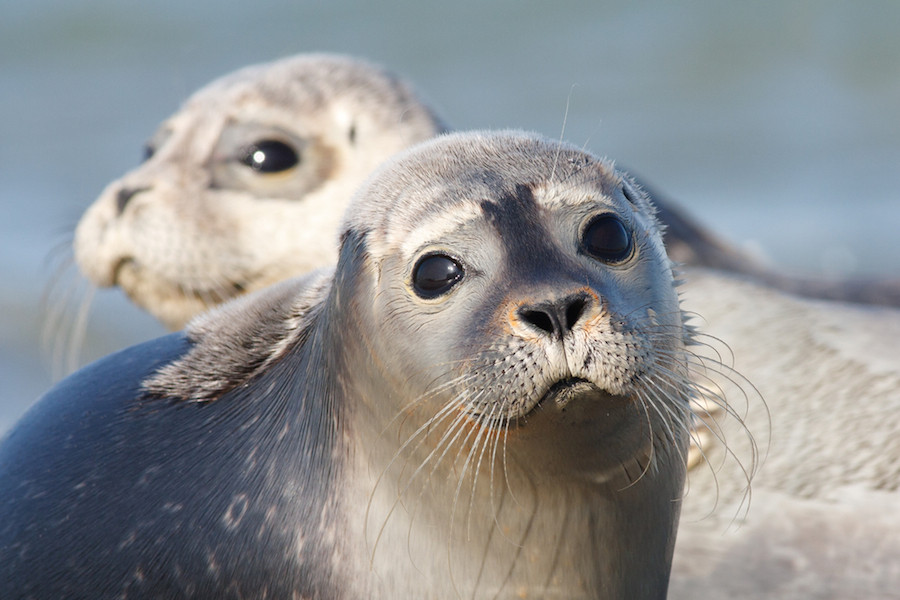
Look at that cute, desperate face! Is it a projection of human emotion onto an animal photograph, or is it distress over a destruction of habitat due to retreating ice?
One of the most easily comprehensible aspects of climate change is that when it gets hotter, ice melts. And, wouldn't you know it, there's a lot of ice near the poles, which is where many seals live. Those that inhabit cold climates need ice for giving birth and nursing, so retreating ice means grave threats to the future of seals.
One of the most easily comprehensible aspects of climate change is that when it gets hotter, ice melts. And, wouldn't you know it, there's a lot of ice near the poles, which is where many seals live. Those that inhabit cold climates need ice for giving birth and nursing, so retreating ice means grave threats to the future of seals.
Polar Bears
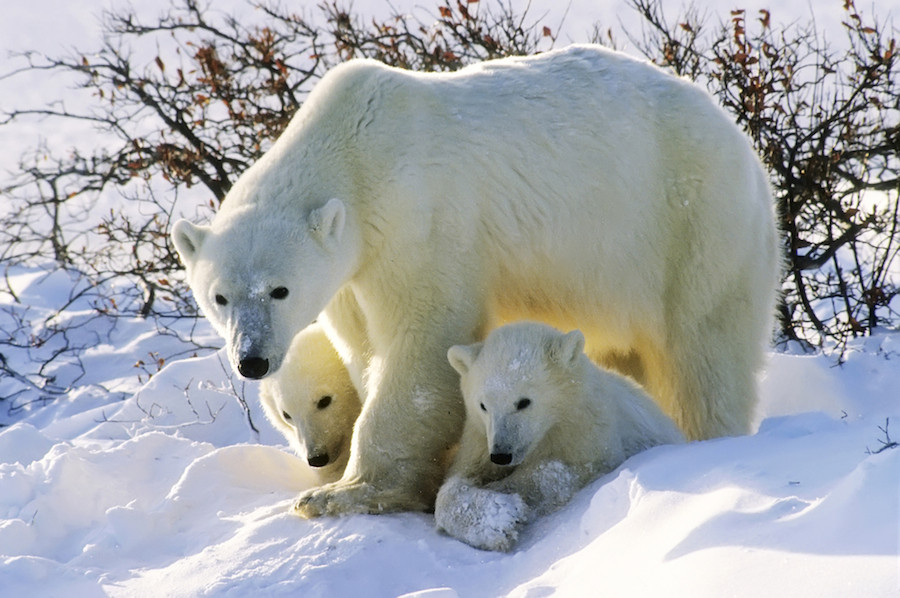
The original symbol of global warming, polar bears also rely on ice, but as a base from which to hunt seals. So dire is their condition that there may be no polar bears within 35 years — that's not very long.
New research on polar bears has complicated the vision of what we can expect in terms of how climate change affects ecosystems, but the message is clear: these changes are real, and they're happening now.
New research on polar bears has complicated the vision of what we can expect in terms of how climate change affects ecosystems, but the message is clear: these changes are real, and they're happening now.
Sea Turtles

Not only do sea turtles lay their eggs on beaches threatened by rising sea levels, but temperature affects the sex of their babies. Warmer conditions mean fewer men, and, eventually, fewer and fewer sea turtles altogether.
North Atlantic Right Whale

The reason you can only see the tail of this whale is that there are fewer than 500 North Atlantic right whales believed to exist. Their rarity initially came as a result of hunting, but sea temperature changes have affected the availability of plankton, the whale's primary food source.
Reindeer
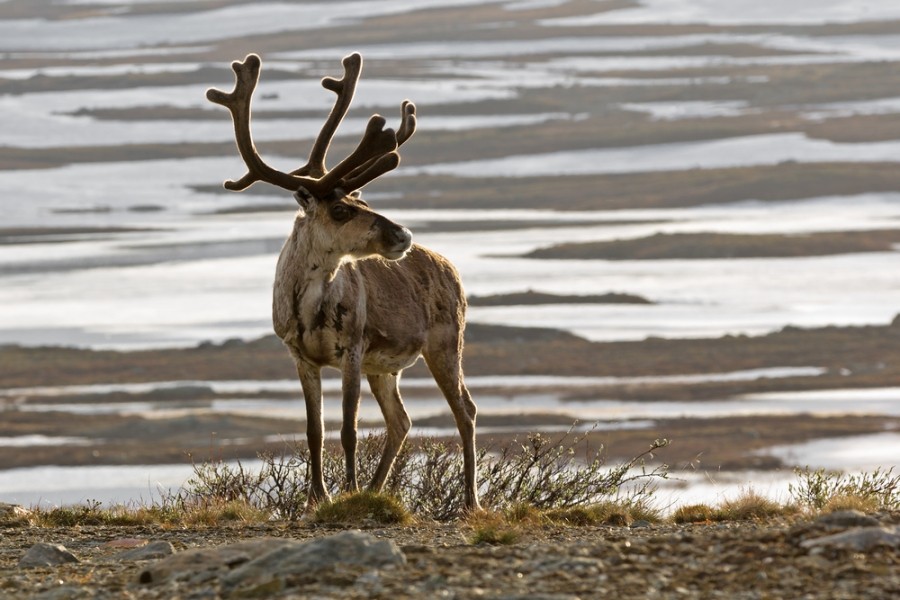
As is the case with most animals residing near the poles, reindeer are on the front lines of climate change. Alterations in the Arctic ecosystem could leave reindeer with too little food, threatening not just the reindeer themselves, but an entire biological web.
Beautiful Nursery Frog
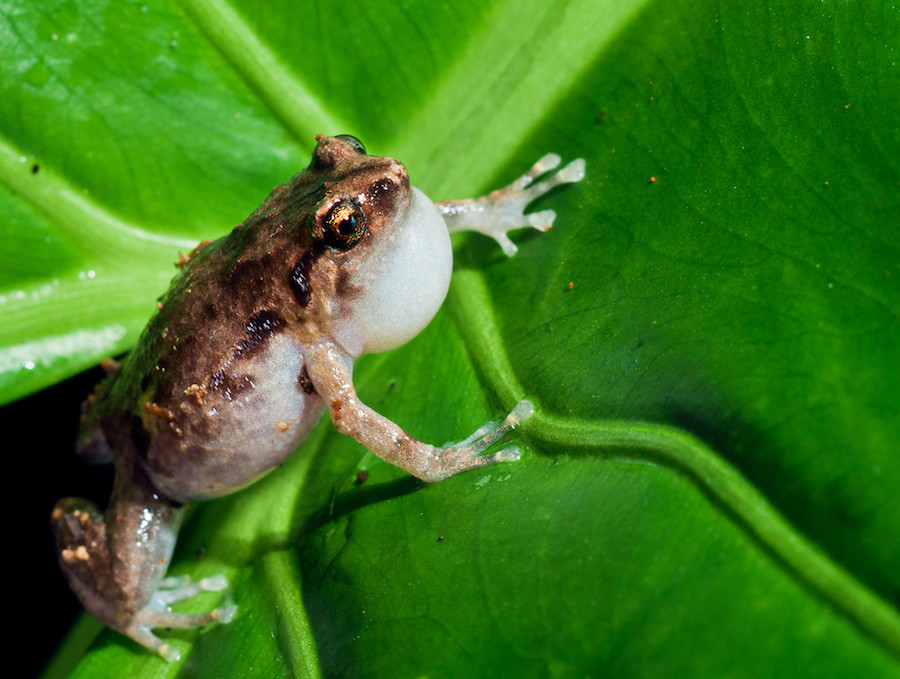
Its name alone won't be able to save the beautiful nursery frog (also called the elegant frog), a native of Australia's rainforest. Because frogs and other amphibians can be so sensitive to small temperature changes, experts fear this little critter could go the way of the golden toad and become a victim of climate change.
Humans

If you're reading this, there's a pretty good chance you're a human being! Since you're a human, there's also a 100% chance that you live on Earth, which in turn means you will feel the effects of global climate change.
It's already happening — maybe not in your backyard, but around the world people are having to change their lives to cope with the damage humans have done to our only home. In fact, the world's first climate change refugees already had to evacuate their home ... five years ago.
The reality is that this list could include any animal, because everything on this planet is connected, and humans have to start making real, lasting change if we want to reverse or mitigate the damage we've already done. We can still make the only Earth we have a decent place to live!
It's already happening — maybe not in your backyard, but around the world people are having to change their lives to cope with the damage humans have done to our only home. In fact, the world's first climate change refugees already had to evacuate their home ... five years ago.
The reality is that this list could include any animal, because everything on this planet is connected, and humans have to start making real, lasting change if we want to reverse or mitigate the damage we've already done. We can still make the only Earth we have a decent place to live!
Want To Be More Self-Aware? Study Says To Make More Eye-Contact
Have you ever wondered why someone is afraid to look you in the eye? New research that appeared in the British Psychological Society's Research Digestfound that looking someone in the eye might make us more physically aware of ourselves, which could be uncomfortable for some.
A research team led by the neuropsychologist Matias Baltazar, found a correlation between making eye contact and feeling self-conscious. That's because when someone's looking right at us, we're more likely to think about what they're seeing.
Thirty-two participants in the study were given a series of positive and negative images on a computer screen and asked to rate their emotional reactions to each. Each image was a photograph of a man or a woman’s face that was either looking directly at the camera, as if making eye contact, or away. The participants were hooked up to a machine that measures the sweatiness of their fingers, to record their emotional reaction.
Research Digest has more:
"The participants' accuracy at judging their own physiological reactions was more accurate for those images that followed a photograph that appeared to be making eye contact. "Our results support the view that human adults' bodily awareness becomes more acute when they are subjected to another's gaze," the researchers said.
And not only was the performance enhancing aspect of eye contact increased, but Baltazar and his team also noted that self-awareness could have direct therapeutic implications on the health of our bodies as well.
They said it could "stimulate interoceptive awareness in people whose condition is associated with interoceptive hyposensitivity, [such as] anorexia nervosa and major depression disorder."
In short, body awareness is amplified when someone is looking right at you. So if you strive for self-awareness and making eye contact helps us become more aware of our selves and our bodies, then why not look people in the eye next time you have a conversation? Sure, it might be a little bit uncomfortable, but it will help you grow.
5 Signs You're Not Respecting Yourself
My journey from the depths of self-hating, suicidal suffering into self-acceptance has taught me that self-love isn’t just a dinner mint. It’s an essential part of being a healthy, happy person and not prioritizing self-care has obvious, dangerous symptoms that are too often ignored.
The first step to overcoming any sort of suffering is self-awareness and that's what I hope the following list can do for you. If you’re exhibiting any of the five signs of lacking self-love below, I hope you’ll take the time, after reading this article, to reconnect with the most important person in your life – you.
1. You feel jealous of other people’s happiness, success and relationships.
As a self-loving person, when I am faced with someone more skilled or accomplished, my immediate reaction is wide-eyed, eager inspiration. I want to learn more, hear more, experience more from this amazing person who can teach me so much.
As a self-judging person, when faced with the same person, I would shrink away feeling jealous, inadequate, and bitter. Sometimes, the feeling would be so intense that I’d begin to hate the other person passionately. But truly, I only hated myself.
2. You chronically tell white lies.
If you’re frequently finding yourself spilling out some fabrication, big or small, and thinking, Wow, that was really unnecessary!, it could be because of your relationship to yourself.
Those who chronically lie are often seeking approval and acceptance from others.
In a self-loving state, acceptance and approval are constantly accessible for you – from within. In a self-judging state, however, you’re running low on approval and, thus, your mind is subconsciously picking up on any and every opportunity to fill up your tank.
Like this, you might lose your integrity for a few raised eyebrows. But don’t worry, this pattern is easily fixed and doesn’t have to become pathological!
3. You find it hard to exercise, eat well, or break bad habits.
When you love someone, you don’t want to hurt them. You’d never shove cigarettes or donuts into your newborn baby’s mouth. You’d never deprive your beloved dog of his daily walk.
When you dislike someone, it’s a different story.
Those who lead kind, loving relationships with themselves find it enjoyable and even necessary to engage in daily rituals of nourishment and care with their minds and bodies. These rituals are just natural outgrowths of the beautiful friendship within.
If you find it hard to take care of yourself, maybe you need to take a moment to fall in love with the person you’re taking care of so that self-care becomes a basic need rather than a distant guilt-inducing fantasy.
4. You only feel happy when everything is going right.
This might seem like a perfectly normal thing. Why would you be happy when things aren’t going well?
Turns out, that is exactly what happens to self-loving people.
Think of your life as an adventure. If you’re crazy about your travel partner, the plane can be delayed and the food can taste like cardboard and you’ll still have a good time. You’ll have a laugh about it. If you’re bored or displeased with your companion, these little things will drive you insane.
That is the power of a loving relationship with yourself. When things get rough, you can laugh, shrug them off, and try again. When things get really rough, you can comfort yourself, take some time to process, and assure yourself that everything will be okay.
5. You're beating yourself up for exhibiting any of the signs above.
If you’re feeling shame or dread at having discovered yourself lacking in self-love, this is a sure-fire sign that you’re overloading on self-judgment.
Those who are lacking in self-compassion are usually experts at setting standards for themselves. They measure themselves in numbers and expectations. When they discover that they’re not measuring up in some way, they’re crestfallen.
I always say: self-improvement without self-love is like building a house upon sand. You can build and build, but it’ll always sink.
You need to build a foundation of unconditional self-acceptance beneath those accomplishments and expectations. Then, when you find you’re lacking in some way, you can revert to love and get excited about learning something new.
I consider myself a survivor of the terrible illness of love deprivation. After I fixed my relationship with myself, I saw my relationship with my body, my mind, my family, my partner, my past – with everything and everyone else – improve dramatically.
We live in an age where everyone’s always trying to fix themselves, but they forget that the most important thing we can ever fix is the line of communication between our heart, our mind, and our spirit.
Now, over to you. What will you do to love yourself more today? How can you celebrate who you already are instead of always expecting yourself to be someone else?
How To Have A Drama-Free Breakup
I was in love. It wasn’t an easy, nurturing, soulful love. It was the kind of love that rocks your foundation and leaves you feeling consumed.
He was the first thing I thought about when I woke up and the last thing I thought about before I went to sleep. He was intense and passionate, but also secretive and disarming.
Just as I became consumed by this drug, needing hit after hit, he began to pull away. He began making less time for me, making me feel very small and unimportant in his life.
He began seeing other women, but wouldn’t completely cut ties with me, periodically reaching out and sending flirtatious texts that kept me sad and confused.
I probably had every right to be angry and I was certainly upset. I think I cried more during the six months that followed than I had my entire life. It brought to the surface so many insecurities and so much self-doubt.
Whenever there’s a breakup or a divorce, there are typically more questions than answers. And those questions can leave us feeling lonely, numb and stuck. They can also leave us feeling mad and frustrated. So, many times, we create drama around this pain as a way to make sense of it.
When our hearts are broken there’s an opening that’s created, a small space, for the light to get through. So when relationships break, we can either make the choice to shut down and not let the light in, sitting there in our anger, pain and bitterness … or we can turn toward that light. We can choose to seek peace instead.
Here are three great reasons to be intentional about choosing peace rather than drama:
1. That drama and stress will show up in your body.
You won’t eat well. You likely won’t sleep well. You may find yourself working longer hours to escape the lack of peace in your life.
2. That drama and stress will show up in your mind.
You may stop doing the things that you love in lieu of spending hours in front of the TV. You may lose focus easily. The stories that you create in your mind will likely become more frequent and louder: I’m not thin enough, I’m not pretty enough, I should have never said that, What if I never find anyone to love me? Stress is directly connected to higher rates of depression and anxiety.
3. That drama and stress will show up in your spirit.
You may notice that your actions and behaviors suddenly aren’t aligning with your values and who you are at your core. That can impact relationships with your friends and family, as well as your work performance.
Choosing peace requires us to ask and answer some key questions:
How can I show love and grace to myself today?
When dealing with a breakup, begin practicing radical self-care. How can you be intentional about making space in your day to do whatever feels good and nurturing and compassionate to yourself? Where can you find 10 minutes for you in your day? What is your body telling you that it needs right now and are you listening?
What do I need to give myself permission to do?
In the midst of a breakup, there may be specific things that you need to give yourself permission to do. I gave myself permission to stop forcing what wasn’t occurring naturally or organically in my life. I gave myself permission to stop comparing myself and my situation to others. I even gave myself permission to have a bad day occasionally, but not to stay there.
What am I to learn?
Just because we don’t understand something right at this moment doesn’t mean that it has no meaning. We are all teachers for one another and our significant others are here to teach us something.
When we can look for the lesson in the situation, that’s when we can begin turning toward the light and being in peace. Making the decision to be peaceful in the midst of a heartbreak is a choice, just like forgiveness is a choice. It's an action that you take to free yourself from the drama, the nonsense and the bitterness.
A Simple Change To Boost Your Joy
How often do you take time to simply play? Take a look at children at recess or in the neighborhood park, and you'll notice the simple joy and freedom they exude as they run and play. Too often we lose this daily carefree playtime as we grow up.
Play involves a state of being in which we're engaged in fun, pleasurable activity. Although play may be perceived as unproductive, immature or trivial in adulthood, play can be beneficial for people of all ages.
Taking a playful approach to life’s tasks is a great way to become more in touch with your inner spirit and reconnect with your true passionate purpose. When you cultivate a playful spirit, you may find that you can approach tasks in a more relaxed and focused manner and develop more creative and innovative solutions to problems.
The novelty and pleasure derived from spontaneous play can strengthen the body, improve our health and stimulate the mind to help expand creativity and productivity. Allowing your creativity to shine can help you to cultivate your passions and build an authentic, balanced life. Play helps us reduce stress, connect with others and increase joy!
Try these strategies to incorporate more play into your day and rediscover the magic of joyful play!
1. Make your own playtime!
There are great places for play all around you, from gyms to parks. Open spaces are great places to engage in playful activities alone or with friends. But you don't need a special location or designated playdate to make your own custom playtime! Reconnect with your inner child and allow yourself to play for fun! Run around a park, build a fort, make up a game, play fetch with your dog or experiment in the kitchen. Incorporate a playful approach to everyday tasks.
2. Consider playtime a mindfulness practice!
Mindfulness is a sought-after state. You may go to your weekly yoga class or sit daily in meditation in search of obtaining this valuable, open presence. Practicing mindfulness improves our physical and mental health and cultivates a greater sense of awareness. Play is a great way to deliberately engage in the present moment.
3. Let your inner child speak passionately to you!
Although our everyday lives can make us feel limited and trapped by an endless to-do list, being fully alive involves letting go and valuing the carefree experience of play along with goal-oriented work. Reflect on things you loved to do as a child. Make a list of ways that you can play. Take time to go out and do something you loved to do as a child or have not done in a while. Feel free to simply enjoy yourself!
4. Remember the way you feel when you're completely free of cares!
What's it like for you to let go, to stop worrying about your to-do list and to take time to simply allow your soul to enjoy the experience of being alive? Incorporating a sense of play into your day-to-day life affirms your joyful spirit, spontaneity and fun. List how play helps you to be more creative, energetic, productive, renewed, joyful, refreshed and happy.
How can you add more play into your life? Even a small shift in your attitude toward play can go a long way toward boosting your creativity, increasing your joy and improving your productivity. Follow these tips and prioritize play in your day!
How To Stop Your Phone From Taking Over Your Life
As I ate dinner one recent Sunday, I scrolled through my social media feeds on my phone. I read about how someone was going to the market to buy groceries, how someone had just moved, how someone had just missed their plane, and how another person’s daughter had just played a piano piece.
On and on it went. I devoured this information while I was shoveling food into my mouth and down into my gut.
Suddenly, something amazing happened; I paused, took a breath and looked up from my iPhone. I was amazed at what I saw. There before me was a stunning sight — a view so breathtaking and beautiful I was mesmerized. I live on a hill with a magnificent view over the city of Sydney. And at that very moment, the sun was setting on my rooftop garden and the sky was orange and pink. How could I have been ignoring this?
There was so much beauty around me, but I had temporarily caught the Distraction Bug and wasn’t taking it all in. After pausing and regrouping, I became present again. The food tasted so much better, I felt calmer and more engaged in the now. Bliss filled me. I was aligned again.
Catching the Distraction Bug is easy. It's a global contagion that's spreading fast. Have you caught it? Here are five tips on how to shake it off. Enjoy!
1. Come to your senses.
Regularly check in with your senses. Your senses operate in present time. What you hear, see, taste, touch and smell is all in the NOW! So throughout the day go through your senses and check in with the information they are offering you.
2. Go on conscious nature walks.
It doesn’t matter where you live; you should be able to find somewhere you can take a slow, conscious walk in nature, even if it's a local park. Stop, look at a leaf, smell a flower, watch an ant, feel the breeze or look at the clouds.
3. Put away all technology during meal time.
If it’s there at the table, the sweet lure of information will suck you in easily.
4. Adopt a one-screen policy at other times.
In our house we have a one-screen policy. Ie. No iPods, iPhones or laptops while watching TV, or any other double or triple combinations of screening!
5. Begin a meditation practice.
Above all, meditate! Meditation helps you be more present throughout the day. It also trains you to observe your mind rather than BE your mind. I recommend two meditations per day for 20 minutes each.
Have you tried any of these tips already? Tell me how it went for you in the comment box below.
Why We're Attracted To People Who Are Wrong For Us
I'm asked this question all the time: "Why am I attracted to people who are wrong for me?" And the answer is quite simple, actually:
Because your wounded self is doing the attracting.
Now, I know the term "wounded self" can sound a little intense, so let me explain. We all have two selves: the "little self" (or the wounded self, the ego) and the "Spiritual Self" (the higher self, adult self, or soul).
The wounded self is the part of you that feels incomplete. It questions your worth and value; it doesn't feel whole, or it feels flawed in some way. My wounded self is the "little me" who wonders if I'm truly lovable.
On the other hand, we also have a Spiritual Self. This is your higher self, your soul. It's the part of you that's connected to love, truth, wisdom and peace within. Your Spiritual Self knows, without a doubt, how lovable and valuable you are. In many ways, it's the opposite of the ego.
At any given time, we are operating from one of these two selves. Many of us, unfortunately, operate from the viewpoint of the ego most of the time. That is, we believe we're insignificant and powerless in some way, and we're trying to make up for this lack.
The ego looks for things on the outside to find validation and completion. It believes once it gets more (money, a better partner, a better job, a better house, more vacations, etc…) it will finally be happy.
But … it's never happy. Not for long, anyway. Because the ego's very nature is to feel incomplete. Therefore when you live through the perspective of your ego, you're destined to feel like something's missing. Life through this lens is not very fun.
The ego gets highly activated when it comes to romantic relationships, because relationships are where we hold the most wounding.
We've all felt disappointed or hurt by a relationship in the past; we carry the memory of this wound into adulthood (sometimes unconsciously). If a wound from childhood is still active within you, you'll attract people who are going to highlight the same feeling. For example, if your wounding is centered around feeling rejected or unseen, it's likely that you'll feel a similar way in your relationships as an adult.
Your unconscious is programmed to attract people who activate your wounds. The reason for this is so you'll grow.
This is a frustrating part of the growth process! But think of it this way: You're replaying your wounds so you can finally heal them. We cannot heal anything we don't feel or see; we can't heal things that are unconscious! The uncomfortable feeling has to come to the surface for you to grow beyond it.
And how do you grow beyond it?
By identifying with your higher self.
Remember, your higher self is the part of you that knows the truth about you. It knows that you are worthy, amazing, capable, and powerful. Through the lens of the higher self, you are whole. Yes, you're an imperfect human with flaws; but the larger truth is: you're a soul.
You're beautiful.You're important.You're special.You're love.
This is what the higher self knows about you — and it wants you to know it, too.
By identifying with your higher self (the love within you), your compulsion to play out wounds with other people dissipates and in some cases, disappears.
When you wake up to the higher self's truth, you suddenly realize that the "wrong" people were just teachers to nudge you into the "right"state-of-mind; a state-of-mind that does not question your value or worth. Unfortunately, nothing inspires us to grow more than a broken heart.
Your higher self wants you to identify with it; it wants you to own who you really are. Reclaim the love within you, and you'll heal your relationships from the inside-out.
Please leave a comment below telling us the qualities of your higher self and how you plan to be more connected to that part of you.
Why Smart Men Do Yoga
Let's begin by identifying an oxymoron: men and yoga!
Generally speaking, it's like oil and water. But men that practice yoga are smart, period. As for those that don’t, well… let me to try to help you.
Let's face it, we men don’t like being vulnerable in front of each other, let alone the opposite sex! And going to a class filled with sweating, half-naked women, and then being asked to move our bodies in ways we never have, is a tall order.
So gentlemen believe me, I get it. But here’s what your missing…
If you don't practice yoga but you consider yourself an intelligent person, did you know that smarts alone aren’t always enough? There is a fundamental difference between knowledge and wisdom.
Knowledge is knowing and wisdom is doing. Knowledge is sight and wisdom is insight.
Yoga teaches us how to convert a head full of information into a life filled with peace and prosperity, and that it’s not what we do in life that ultimately matters — it's how we do it!
Every man could use this lesson. The job does not make the man. The man makes the job.
Yoga teaches us there is no place for the ego if we want true peace in our lives. The ego only produces fear. And without fear, we are not concerned with what we will lose or never gain in this world. We are simply delighted to use our talents and resources to serve all of humanity.
A Navy Seal that attended my class recently said to me, “that was the toughest workout I've ever had in my life, even tougher than Seal training.” Yoga will prepare you for every sport and every activity. But nothing prepares you for yoga.
Clint Eastwood stated in one of his finest movies, Sudden Impact, that “a man's got to know his limitations.” Clint’s a smart man and a serious meditator. And like Clint, yoga will teach you how to honor your limitations.
Yoga also makes us more comfortable in our skin and feel really good about ourselves. We learn to see ourselves through a different kind of mirror — an internal mirror. You can look good on the outside, but that doesn’t mean you are going to feel good on the inside. But once we feel good from the inside-out, we are going to look really good as a result.
So guys, try to remember that yoga is not easy in any form, but it will make your life a whole lot easier. If you consider yourself a smart man, then get out there and try some yoga today!
Subscribe to:
Comments (Atom)
